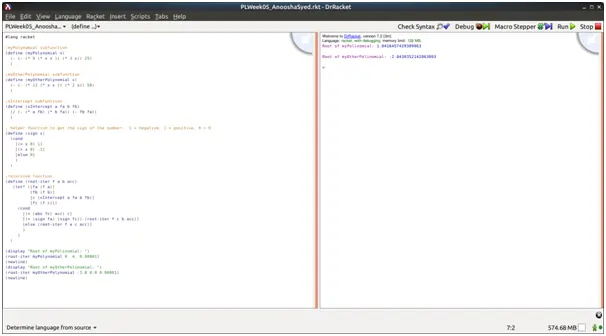Instructions
Objective
Write a racket assignment program to create a BST tree.
Requirements and Specifications
Write a recursive function that finds a zero of a polynomial using the false position method.
The function takes 3 parameters: The polynomial function and two starting values.
Test this function with the two following polynomials:
For the function 9x2 - 3x - 25, you can use starting values 0 and 4:
Which evaluate to -25 and 107 respectively
You can assume that the two starting x values evaluate to y values that are on opposite sides of the x axis. (i.e. one y value is positive, the other negative)
For the function y = 11x2 - 2x – 50, you can use starting values -5 and 1:
Which evaluate to 235 and -41 respectively
Print out the final x value.
Helpful subfunctions:
a subfunction to decide if the current y value is accurate enough. The accuracy can be hard coded (0.001 or 0.0001 or so) or can be a parameter.
a subfunction that calculates the x-intercept of a line segment given two endpoints.
Screenshots of output

Source Code
#lang racket
;myPolynomial subfunction
(define (myPolynomial x)
(- (- (* 9 (* x x )) (* 3 x)) 25)
)
;myOtherPolynomial subfunction
(define (myOtherPolynomial x)
(- (- (* 11 (* x x )) (* 2 x)) 50)
)
;xIntercept subfunction
(define (xIntercept a fa b fb)
(/ (- (* a fb) (* b fa)) (- fb fa))
)
; helper function to get the sign of the number: -1 = negative, 1 = positive, 0 = 0
(define (sign x)
(cond
[(> x 0) 1]
[(< x 0) -1]
[else 0]
)
)
;recursive function
(define (root-iter f a b acc)
(let* ([fa (f a)]
[fb (f b)]
[c (xIntercept a fa b fb)]
[fc (f c)])
(cond
[(< (abs fc) acc) c]
[(= (sign fa) (sign fc)) (root-iter f c b acc)]
[else (root-iter f a c acc)]
)
)
)
(display "Root of myPolinomial: ")
(root-iter myPolynomial 0. 4. 0.00001)
(newline)
(display "Root of myOtherPolinomial: ")
(root-iter myOtherPolynomial -3.0 0.0 0.00001)
(newline)
Related Samples
At ProgrammingHomeworkHelp.com, we offer specialized support for programming assignments using Racket. Our curated samples demonstrate efficient coding techniques and solutions tailored to students' needs. Whether you're grappling with recursion, macros, or functional programming concepts, our expert assistance ensures clarity and academic success. Explore our resources to enhance your understanding and excel in your Racket assignments with confidence.
Programming
Programming
Programming
Programming
Programming
Programming
Programming
Programming
Programming
Programming
Programming
Programming
Programming
Programming
Programming
Programming
Programming
Programming
Programming
Programming
